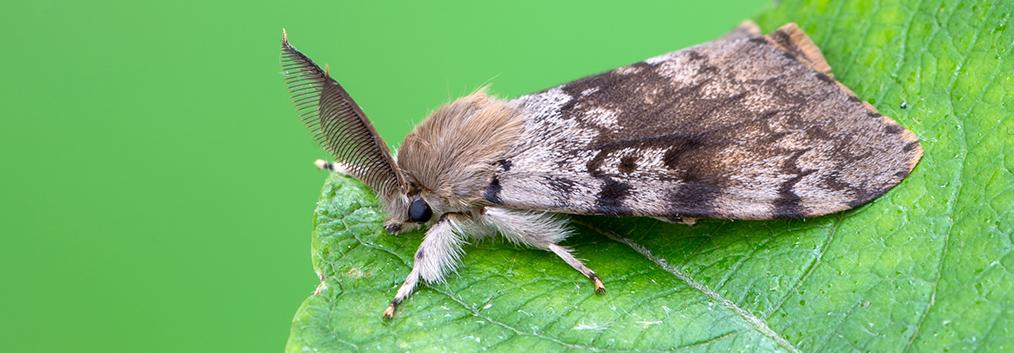
Lymantria dispar, commonly known as Spongy Moth and formerly known as Gypsy Moth, is a non-native pest that has few predators. The caterpillar stage of its life cycle feeds on tree leaves, preferring those of oak, aspen, poplar, and birch but will feed on over 500 other types of plants throughout the summer. Left alone, large populations have the ability to defoliate entire wooded areas covering thousands of acres.
Population outbreaks began to appear in Michigan's lower peninsula in the mid-1980’s and while populations cannot be completely eradicated, they can be suppressed to tolerable levels. In 1993 Macomb County established the Lymantria dispar Suppression Program in an effort to control the Lymantria dispar population in Macomb County. The program is administered by Michigan State University (MSU) Extension and is provided to residents in both rural and urban areas within the county.
What happens when trees are defoliated?
Trees defoliated more than 40% become stressed by using next year’s energy reserves to grow new leaves during the same season. Healthy trees may withstand several years of defoliation. Evergreens are unable to replace their needles and may die when defoliated. Keep trees watered and fertilized to reduce any stress.
How do Lymantria dispar travel?
There are a number of ways Lymantria dispar travel. The most notable method is wind, when caterpillars hang in trees on a silk strand and can be carried a great distance by wind or strong breezes. Humans have also been known to move egg masses or pupal cases that were attached to travel trailers, firewood, cars, recreational vehicles etc.
What does Lymantria dispar damage look like?
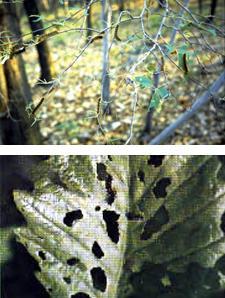
Lymantria dispar caterpillars feed on tree leaves creating ‘swiss cheese’ type holes. They do not cause pre-mature leaf drop, browning, or curling of leaves. They do not make a web or tent in trees. In addition to damage to the trees, LD caterpillars can be a nuisance if populations are high enough. Caterpillars and their frass (feces) can drop down from trees on to sidewalks, driveways, yards, porches, and vehicles. The hairs on the caterpillars can cause irritation or an allergic reaction to bare skin. Frass can stain surfaces, especially if it is rained on or becomes wet.
How do I know if I have Lymantria dispar on my property?
A number of MSU Extension bulletins can help you identify the Lymantria dispar and caterpillar. You can also use the Macomb County MSU Extension diagnostic facility. There is a small fee for some services.
Should I report an LD infestation?
Yes! To determine if your property is eligible for the Lymantria dispar Suppression Program, report all infestations to the program coordinator at the Macomb County MSU Extension office. An egg mass survey can be done to assess the level of infestation and determine if an area qualifies for the program.
Please use this short form to report any Spongy Moth sitings and a MSUE staff member will follow up with you.
For more information, please contact:
Macomb MSU Extension Lymantria dispar Suppression Program (586) 469-6432.
What are the goals of the Lymantria dispar Suppression Program?
-
Reduce high caterpillar populations to tolerable levels
-
Reduce tree loss by preserving at least 60% tree foliage, to reduce stress on trees
-
Prevent indiscriminate use of chemical controls
-
Provide educational information
MSU Extension staff held an informational webinar about the Lymantria dispar Suppression program in February, 2021. View the recording.
How are Lymantria dispar populations suppressed?
The main defense is an aerial application of Bacillus thuringiensis var. kurstaki (Btk), used to reduce high populations of Lymantria dispar caterpillars at sites that meet certain guidelines for treatment. Btk is a naturally occurring bacterium found in the soil and is not harmful to pets, birds, fish, plants, beneficial insects, or humans. Btk specifically targets only caterpillars of a certain age. It is applied when the caterpillars are young (usually in May) to insure the greatest impact in reducing numbers. Alternative mechanical techniques, such as tree banding, egg mass scraping, and hormone traps to help reduce populations. The Suppression Program recommends the use of a combination of methods.
The life cycle of the Lymantria dispar
There are four stages to the life cycle of the Lymantria dispar. They are the egg stage, catepillar stage, pupae stage and moth stage.
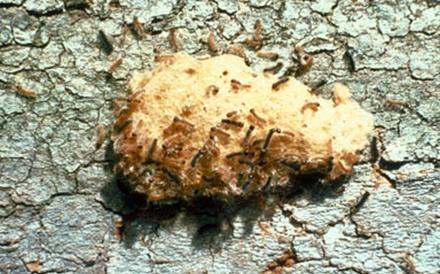
Lymantria dispar egg mass starting to hatch with many small caterpillars emerging.
Photo credit: USDA Forest Service, USDA Forest Service, Bugwood.org

The eggs hatch into caterpillars late April or early May. Hatch date is directly affected by weather. The colder the spring, the later the eggs hatch. A healthy egg mass can hold 1000 eggs, although the average is probably between 300 and 500. Once the eggs hatch, the caterpillars will remain on the egg mass for a few days before they leave to feed. In its short lifetime, a caterpillar can eat one square meter of leaves. Mature caterpillars are about 2” in length with long hairs grouped in bundles. They have 5 pairs of blue dots and 6 pairs of red dots running down their backs. Their heads are black with yellow markings.
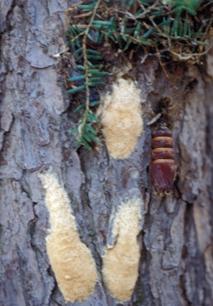
In mid-July to mid-August, mature caterpillars stop feeding and weave silk around their bodies to form a hard, brown shell or cocoon. In this pupa stage, caterpillars start their metamorphosis or change into the moth stage of the life cycle. This process takes about two weeks.
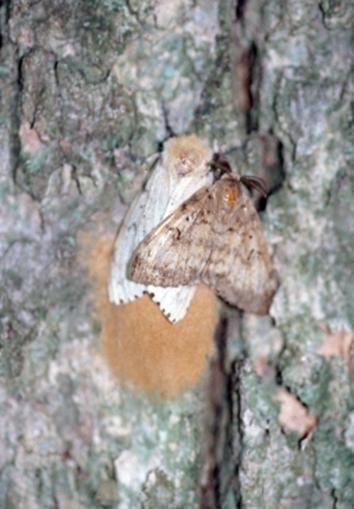
Moths, the adult stage of the life cycle, emerge from the pupal cases in mid-August. The moths do not eat and they live only for a week. Female moths have white wings with brown chevron or ‘V-shaped’ markings and do not fly. Male moths have smaller brown wings and are able to fly. Attracted to a pheromone emitted by the female, the males can fertilize several females before dying. Female moths lay egg masses that remain dormant until spring.
Upcoming Events
2024
- Early spring survey - not required based on Fall 2023 survey findings.
- Late spring (May) aerial suppression spray - not required for 2024.
- Fall egg mass survey - Dates have not yet been determined.
2023
- Early spring survey - completed.
- Late spring (May) aerial suppression spray - completed.
- Fall egg mass survey - completed; minimal egg masses identified.
Useful Links and Factsheets
- About Lymantria dispar - Trifold Printable Brochure, MSU Extension
- Lymantria dispar - Integrated Pest Management, Michigan State University
- Lymantria dispar outbreaks in Michigan, MSU Extension
- Btk: One management option for Lymantria dispar, MSU Extension
- European Gypsy Moth, USDA APHIS
- Gypsy Moth, Penn State University Extension






